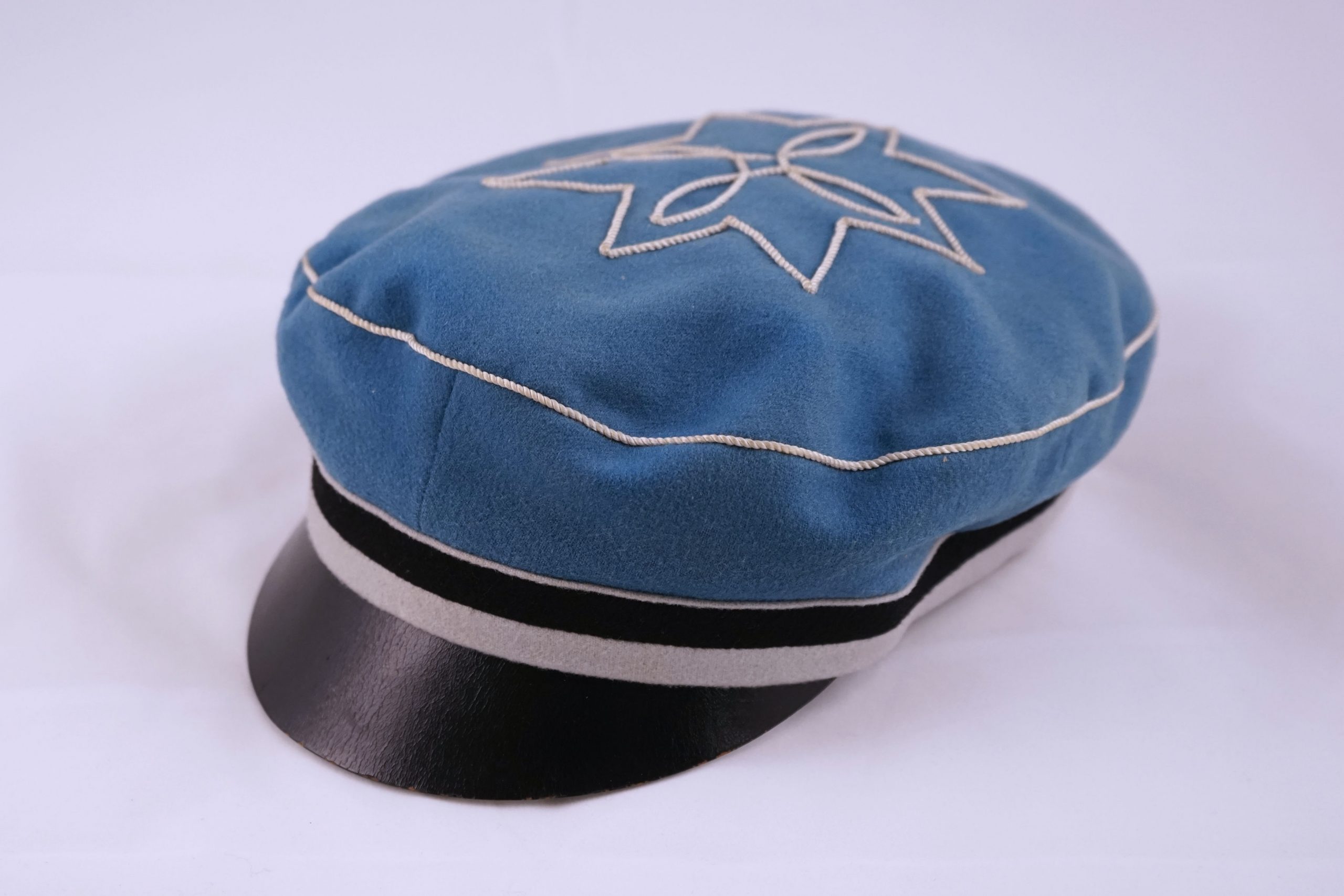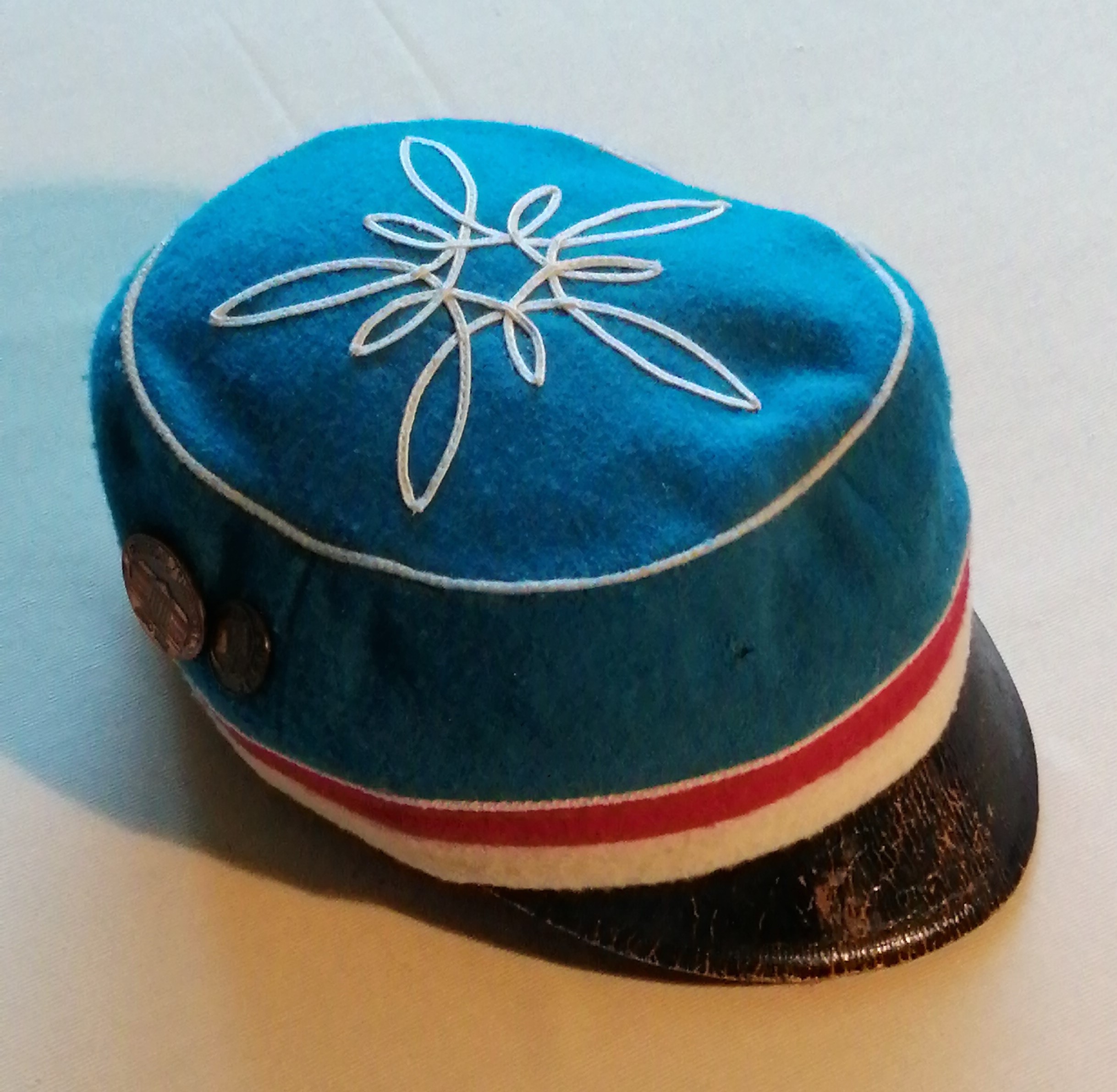In honour of the 390th anniversary of the University of Tartu on 30 June 2022, our object of the month is the cap of the first Estonian student organisation. We are also presenting a student cap from the Soviet era and the Estonian cap tradition more broadly.

The cap of a Finnish scholarship recipient
The cap included in the collections of the Helsinki University Museum is that worn by members of the Estonian Students’ Society (Eesti Üliõpilaste Selts, EÜS). It originally belonged to Professor Martti Salmi (1908–1997), who had studied palaeontology on a scholarship at the University of Tartu from 1936 to 1937. The future professor was a member of EÜS’s Finnish twin association, the Etelä-Pohjalainen osakunta student nation, and was accepted as a member of EÜS during his studies in Tartu. In the period between the two World Wars, Finnish and Estonian student organisations cooperated actively and granted scholarships that enabled Estonians to study in Helsinki and Finns in Tartu.
The Estonian tradition of student caps
The Estonian tradition of student caps dates back to the early 19th century and differs slightly from that in Finland. The University of Tartu suspended its operations during the Great Northern War in 1710, but reopened in 1802. In the 1820s, local Baltic-German students began to establish fraternities, known as corporations, following the example of German universities. A corporation was a student organisation with its own rules and symbols. It usually chose three official colours that appeared on its cap and sash. Hence, unlike in Finland, no cap worn by all students was introduced in Tartu in the 19th century, but rather each student organisation had its own cap and colours. Student organisations were established not only by the Baltic Germans, but also by Polish, Russian and Jewish students.
The first Estonian student organisation
Initially, the student corporations were semi-secret because they were banned at the University of Tartu. The corporations received official status in 1855, and their representatives formed the ‘Chargiertenconvent’, the highest body of the local student union. Establishing a new corporation required permission from the Chargiertenconvent.
In the first half of the 19th century, the University of Tartu only had a handful of Estonian students, who usually joined the Baltic-German corporations. Towards the latter part of the century, the number of Estonian students increased, and they began to toy with the idea of establishing their own organisation. In spring 1870, a small group of students and cultural figures started to meet in Tartu. They discussed ways to promote the Estonian identity and talked about the recently published national epic, Kalevipoeg. The meetings dedicated to discussion on Kalevipoeg, gradually attended by an increasing number of Estonian students, gave the impetus to establish a separate organisation for Estonian students, the Estonian Students’ Society (Eesti Üliõpilaste Selts, EÜS).
In fact, the Estonians had wished to establish a corporation called Vironia, but were rebuffed by the Chargiertenconvent. As the establishment of a society only required the rector’s permission, in 1883 the rector of the University of Tartu registered the Estonians’ organisation as an academic student organisation known as EÜS. However, EÜS itself considers the first Kalevipoeg meeting on 7 April 1870 as the date of its establishment. According to the rules, a society was not allowed to have official colours, but EÜS adopted the blue-black-and-white colour combination originally planned for Vironia. Their flag was secretly dedicated in Otepää in June 1884 and then hidden in the society’s facilities. Caps and sashes were also initially used only in the society’s own facilities and in closed events.
The student flag becomes the nation’s flag
The EÜS flag later became the flag of the independent Estonia. The blue-black-and-white flag was adopted as the national emblem during the Russian Revolution of 1905, and after Estonia declared its independence, the country’s parliament confirmed it as the national flag in the early 1920s. Today, the original flag, dedicated in Otepää, is on display at the Estonian National Museum in Tartu. The flag survived the period of historical turmoil because Karl Aun, the then-chair of EÜS, hid it on his home farm in 1940. The flag remained hidden until 1988 in a location known only to a few.
Introducing a white cap
It was not until the beginning of the 20th century that the first Estonian corporations, Fraternitas Estica (1907) and Sakala (1909) were established. After Estonia gained its independence, more corporations were set up, and women students, who officially received the right to study at universities in 1915, began to establish their own organisations. The tradition of separate corporations for men and women has continued in Estonia.
Although each corporation had its own cap, students also felt the need for a general student cap. In 1919 the University’s official language was changed to Estonian, and the idea of kindred nations spread among students. The students were also keen to belong to the community of Nordic students. Accordingly, in 1922 students at the University of Tartu began to wear a white student cap to underline their connection with the Nordic countries. Sources suggest, however, that the cap differed in some respects from the one worn in Finland: the band of the white cap was not black but dark blue.
Changes under Soviet rule
All student associations and their symbols were banned in Estonia in 1940, but the idea of the cap lived on during the Soviet era. In 1957 the University of Tartu introduced a blue cap with a red-and-white band, symbolising the colours of the flag of Soviet-Estonia. The initiative for the new cap likely came from the leader of the University of Tartu’s branch of the Communist Party. It is said that the first samples sent to the University were, for some reason, of the banned blue-black-and-white colour scheme; but the party leader had the idea of replacing the black band with a red one, thus creating an ‘ideologically correct’ cap.

The blue-red-and-white cap of the University of Tartu became very popular, and students wore it with pride. The fact that the colours were those of the Soviet-Estonian flag made no difference in the end. The flag was a powerful symbol of the University of Tartu and signified above all that the person wearing it was a student at the country’s most prestigious university. First-year students usually received their caps at a freshers’ event. Because a brand-new cap immediately revealed that its owner was a first-year student, some tried to customise their cap to make it look older, for example, by washing it with beer.
Other Estonian higher education institutions followed the University of Tartu’s example. The other higher education institution in Tartu, the Estonian Agricultural Academy (later the Estonian Agricultural University and now the Estonian University of Life Sciences), introduced a green cap with a black-and-yellow band. The playful rivalry between the Academy’s students and the University’s students also extended to the caps: the University students called the Academy’s green cap a ‘cabbage leaf’ whereas the Academy students referred to the University’s blue cap as an ‘ink spot’.
Independent Estonia reinstates corporations
The blue-red-and-white cap remained in use until the 1990s. A new era dawned in Estonia in the late 1980s, eventually leading to the country regaining its independence in 1991. Former corporations began to be re-established in the late 1980s: one of the first to continue its operations was EÜS in 1989. Corporations also reintroduced their historical caps and colours, and the Soviet-era cap disappeared almost spontaneously.
However, the majority of students were not members of any corporations. Occasionally, the idea arose of a general student cap, with a white cap as the prime candidate due to its history as the emblem of university students in the Nordic countries. In 2007 the University of Tartu reinstated the white cap, which was redesigned in 2020. The new version of the white cap has a blue band symbolising the University’s main colour, and a silver badge of six pillars (representing the portico of the University’s main building) and the year of establishment, 1632.
LicPhil Merike Holmberg, customer advisor, guide, alumna of the University of Tartu
Translation: University of Helsinki Language Services.
Sources:
Hiio, Toomas. “Nemad valisid värvid”. https://www.postimees.ee/2487561/nemad-valisid-värvid [accessed on 20 May 2022].
Hiio, Toomas. “150 vuotta Virolaisten Ylioppilaiden Seuran perustamisesta” Elo 3/2020. https://www.tuglas.fi/150-vuotta-virolaisten-ylioppilaiden-seuran-perustamisesta [accessed on 20 May 2022].
Martti Salmen rahasto. https://apurahat.skr.fi>nimikkorahastoesite
Meri, Hindrek-Peeter. “Üliõpilasmütsi saamisloost”. Universitas Tartuensis: Tartu Ülikooli ajaleht nr.17, 3. mai 2002. https://dea.digar.ee/article/universitas/2002/05/03/21 [accessed on 20 May 2022].
“Mida arvate Tartu ülikooli teklist?”. Universitas Tartuensis: 17, 3. mai, 2002. https://dea.digar.ee/article/universitas/2002/05/03/23 [accessed on 20 May 2022].
Mäekivi, Mirjam. “Tartu Ülikool saab taas oma tekli”. https://www.postimees.ee/1685983/tartu-ulikool-saab-taas-oma-tekli [accessed on 20 May 2022].
Sootak, Varje. “Kõik ühe mütsi all”. Universitas Tartuensis. 3. mai, 2002. https://dea.digar.ee/article/universitas/2002/05/03/22 [accessed on 20 May 2022].
Truman, Mihkel. “Tartu üliõpilaskonna välissuhtlus 1920. ja 30. aastatel”. Universitas Tartuensis Mai 2019, nr.5. https://www.ajakiri.ut.ee/artikkel/3220 [accessed on 20 May 2022].
Uudis. Detsember 2020, nr.11. https://www.ajakiri.ut.ee/artikkel/3878
“Üliõpilasmüts”. Päewaleht 30. detsember, 1921, Leht 2. https://dea.digar.ee/article/paevalehtew/1921/12/30/6 [accessed on 20 May 2022].
